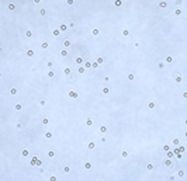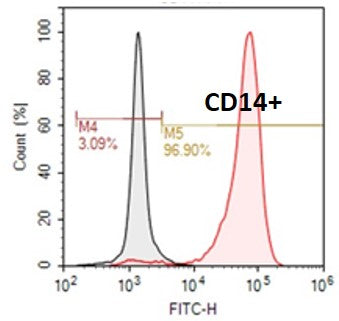Human Cord Blood CD34+ Stem / Progenitor Cells
Also available from 
- NC1853401 (Frozen, Mixed donors, 1 million, Cat#: CBCD34mix-C1M)
- NC1956448 ( Frozen, Single donor, 1 million, Cat#: CBCD34-C1M)
CD34 is a glycosylated transmembrane protein and represents a well-known marker for primitive blood- and bone marrow-derived progenitor cells, especially for hematopoietic and endothelial stem cells. CD34+ stem cells are multipotent and can differentiate to all hematopoietic cell types in blood. CD34+ cells can also give rise to all lymphohematopoietic lineages even though they comprise only a small percentage of the cell population.
Our CD34+ cells are isolated using positive immunomagnetic cell separation procedures from single or mixed healthy donors. All cord blood is collected in Citric Phosphate with Dextrose Buffer (CPD) from fully consented IRB approved donors.

Figure 1. Flow cytometric analysis showed that >90% of the cells are CD34+ (CB CD34+)
CD34 is a cluster of differentiation (CD) first described independently by Civin et al. and Tindle et al.[6][7][8][9] in a cell surface glycoprotein and functions as a cell-cell adhesion factor. It may also mediate the attachment of stem cells to bone marrow extracellular matrix or directly to stromal cells.
Function of CD34
The CD34 protein is a member of a family of single-pass transmembrane sialomucin proteins that show the expression on early hematopoietic and vascular-associated tissue.[10] However, little is known about its exact function.[11]
CD34 is also an important adhesion molecule and is required for T cells to enter lymph nodes. It is expressed on lymph node endothelium, whereas the L-selectin to which it binds is on the T cell.[12][13] Conversely, under other circumstances, CD34 has been shown to act as molecular "Teflon" and block mast cell, eosinophil, and dendritic cell precursor adhesion, and to facilitate opening of vascular lumina.[14][15] Finally, recent data suggest CD34 may also play a more selective role in the chemokine-dependent migration of eosinophils and dendritic cell precursors.[16][17] Regardless of its mode of action, under all circumstances, CD34, and its relatives podocalyxin and endoglycan, facilitate cell migration.[10][16]
CD34 Tissue Distribution
Cells expressing CD34 (CD34+ cell) are normally found in the umbilical cord and bone marrow as hematopoietic cells, or in mesenchymal stem cells, endothelial progenitor cells, endothelial cells of blood vessels but not lymphatics (except pleural lymphatics), mast cells, a sub-population dendritic cells (which are factor XIIIa-negative) in the interstitium and around the adnexa of dermis of skin, as well as cells in soft tissue tumors like dermatofibrosarcoma protuberans (DFSP), gastrointestinal stromal tumors (GISTs), solitary fibrous tumor (SFT), hemangiopericytoma (HPC), and to some degree in malignant peripheral nerve sheath tumors (MPNSTs), etc. The presence of CD34 on non-hematopoietic cells in various tissues has been linked to progenitor and adult stem cell phenotypes.[18]
It is important to mention that Long-Term Hematopoietic Stem Cells (LT-HSCs) in mice and humans are the hematopoietic cells with the greatest self-renewal capacity. Human HSCs express the CD34 marker.
CD34 is expressed in roughly 20% of murine hematopoietic stem cells,[19] and can be stimulated and reversed.[20]
Clinical applications
CD34+ cells may be isolated from blood samples using immunomagnetic or immunofluorescent methods.
Antibodies are used to quantify and purify hematopoietic progenitor stem cells for research and for clinical bone marrow transplantation. However, counting CD34+ mononuclear cells may overestimate myeloid blasts in bone marrow smears due to B lymphocyte precursors and CD34+ megakaryocytes.
Cells observed as CD34+ and CD38- are of an undifferentiated, primitive form; i.e., they are multipotential hemopoietic stem cells. Thus, because of their CD34+ expression, such undifferentiated cells can be sorted out.
In tumors, CD34 is found in alveolar soft part sarcoma, preB-ALL (positive in 75%), AML (40%), AML-M7 (most), dermatofibrosarcoma protuberans, gastrointestinal stromal tumors, giant cell fibroblastoma, granulocytic sarcoma, Kaposi’s sarcoma, liposarcoma, malignant fibrous histiocytoma, malignant peripheral nerve sheath tumors, meningeal hemangiopericytomas, meningiomas, neurofibromas, schwannomas, and papillary thyroid carcinoma.
A negative CD34 may exclude Ewing's sarcoma/PNET, myofibrosarcoma of the breast, and inflammatory myofibroblastic tumors of the stomach.
Injection of CD34+ hematopoietic Stem Cells has been clinically applied to treat various diseases including Spinal Cord Injury,[21] Liver Cirrhosis[22] and Peripheral Vascular disease.[23] Research has shown that CD34+ cells are relatively more in men than in women in the reproductive age among Spinal Cord Injury victims.[24]
References
- "Human PubMed Reference:". https://www.ncbi.nlm.nih.gov/pubmed?linkname=gene_pubmed&from_uid=947
- "Mouse PubMed Reference:". https://www.ncbi.nlm.nih.gov/pubmed?linkname=gene_pubmed&from_uid=12490
- "Entrez Gene: CD34 CD34 molecule". https://www.ncbi.nlm.nih.gov/gene?Db=gene&Cmd=ShowDetailView&TermToSearch=947
- Simmons DL, Satterthwaite AB, Tenen DG, Seed B (Jan 1992). "Molecular cloning of a cDNA encoding CD34, a sialomucin of human hematopoietic stem cells". Journal of Immunology. 148 (1): 267–71. PMID 1370171.
- Satterthwaite AB, Burn TC, Le Beau MM, Tenen DG (Apr 1992). "Structure of the gene encoding CD34, a human hematopoietic stem cell antigen". Genomics. 12 (4): 788–94. PMID 1374051. doi:10.1016/0888-7543(92)90310-O.
- Civin CI, Strauss LC, Brovall C, Fackler MJ, Schwartz JF, Shaper JH (1984). "Antigenic analysis of hematopoiesis. III. A hematopoietic progenitor cell surface antigen defined by a monoclonal antibody raised against KG-1a cells". Journal of Immunology. 133 (1): 157–65. PMID 6586833.
- Tindle RW. Nichols R. Chan L. Campana D. Birnie GD. (1985). "A novel monoclonal antibody BI-3C5 recognises myeloblasts and non-B, non-T lymphoblasts in acuteleukaemia and CGL blast crises, and react with immature cells in normal bone marrow". Leukaemia Research. 9: 1–9. doi:10.1016/0145-2126(85)90016-5.
- Tindle RW. Katz F. Martin H. Watt D. Catovsky D. Janossy G. Greaves M. (1987). "BI-3C5 (CD34) defines multipotential and lineage restricted progenitor cells and their leukaemic counterparts .". In 'Leucocyte typing 111: White cell differentiation antigens. Oxford University Press, 654-655.
- Loken M. Shah V. Civin CI.. (1987). "Characterization of myeloid antigens on human bone marrow using multicolour immunofluorescence". In: McMichael, Leucocyte Typing III:White cell differentiation antigens.Oxford University Press 630-635.
- Nielsen JS, McNagny KM (Nov 2008). "Novel functions of the CD34 family". Journal of Cell Science. 121 (Pt 22): 3683–92. PMID 18987355. doi:10.1242/jcs.037507.
-
Furness SG, McNagny K (2006). "Beyond mere markers: functions for CD34 family of sialomucins in hematopoiesis".
Immunologic Research. 34 (1): 13–32. PMID 16720896. doi:10.1385/IR:34:1:13. -
Berg EL, Mullowney AT, Andrew DP, Goldberg JE, Butcher EC (Feb 1998). "Complexity and differential expression of
carbohydrate epitopes associated with L-selectin recognition of high endothelial venules". The American Journal of Pathology. 152 (2): 469–77. PMC 1857953 . PMID 9466573. -
Suzawa K, Kobayashi M, Sakai Y, Hoshino H, Watanabe M, Harada O, Ohtani H, Fukuda M, Nakayama J (Jul 2007).
"Preferential induction of peripheral lymph node addressin on high endothelial venule-like vessels in the active phase of ulcerative colitis". The American Journal of Gastroenterology. 102 (7): 1499–509. PMID 17459027. doi:10.1111/j.1572-0241.2007.01189.x. -
Drew E, Merzaban JS, Seo W, Ziltener HJ, McNagny KM (Jan 2005). "CD34 and CD43 inhibit mast cell adhesion and are
required for optimal mast cell reconstitution". Immunity. 22(1): 43–57. PMID 15664158. doi:10.1016/j.immuni.2004.11.014. - Strilić B, Kucera T, Eglinger J, Hughes MR, McNagny KM, Tsukita S, Dejana E, Ferrara N, Lammert E (Oct 2009). "The molecular basis of vascular lumen formation in the developing mouse aorta". Developmental Cell. 17(4): 505–15. PMID 19853564. doi:10.1016/j.devcel.2009.08.011.
- Blanchet MR, Maltby S, Haddon DJ, Merkens H, Zbytnuik L, McNagny KM (Sep 2007). "CD34 facilitates the development of allergic asthma". Blood. 110 (6): 2005–12. PMID 17557898. doi:10.1182/blood-2006-12-062448.
- Blanchet MR, Bennett JL, Gold MJ, Levantini E, Tenen DG, Girard M, Cormier Y, McNagny KM (Sep 2011). "CD34 is required for dendritic cell trafficking and pathology in murine hypersensitivity pneumonitis". American Journal of Respiratory and Critical Care Medicine. 184 (6): 687–98. PMC 3208601 . PMID 21642249. doi:10.1164/rccm.201011-1764OC.
- Sidney LE, Branch MJ, Dunphy SE, Dua HS, Hopkinson A (Jun 2014). "Concise review: evidence for CD34 as a common marker for diverse progenitors". Stem Cells. 32 (6): 1380–9. PMC 4260088. PMID 24497003. doi:10.1002/stem.1661.
-
Ogawa M, Tajima F, Ito T, Sato T, Laver JH, Deguchi T (Jun 2001). "CD34 expression by murine hematopoietic stem cells.
Developmental changes and kinetic alterations". Annals of the New York Academy of Sciences. 938: 139–45. Bibcode:2001NYASA.938..139O. PMID 11458501. doi:10.1111/j.1749-6632.2001.tb03583.x. - Tajima F, Sato T, Laver JH, Ogawa M (Sep 2000). "CD34 expression by murine hematopoietic stem cells mobilized by granulocyte colony-stimulating factor". Blood. 96(5): 1989–93. PMID 10961905.
- Srivastava A, Bapat M, Ranade S, Srinivasan V, Murugan P, Manjunath S, Thamaraikannan P, Abraham S (2010). "Autologous Multiple Injections of in Vitro Expanded Autologous Bone Marrow Stem Cells For Cervical Level Spinal Cord Injury - A Case Report". Journal of Stem Cells and Regenerative Medicine.
- Terai S, Ishikawa T, Omori K, Aoyama K, Marumoto Y, Urata Y, Yokoyama Y, Uchida K, Yamasaki T, Fujii Y, Okita K, Sakaida I (Oct 2006). "Improved liver function in patients with liver cirrhosis after autologous bone marrow cell infusion therapy". Stem Cells. 24 (10): 2292–8. PMID 16778155. doi:10.1634/stemcells.2005-0542.
- Subrammaniyan R, Amalorpavanathan J, Shankar R, Rajkumar M, Baskar S, Manjunath SR, Senthilkumar R, Murugan P, Srinivasan VR, Abraham S (Sep 2011). "Application of autologous bone marrow mononuclear cells in six patients with advanced chronic critical limb ischemia as a result of diabetes: our experience". Cytotherapy. 13 (8): 993–9. PMID 21671823. doi:10.3109/14653249.2011.579961.
-
Dedeepiya V, Rao YY, Jayakrishnan G, Parthiban JK, Baskar S, Manjunath S, Senthilkumar R, Abraham S (2012). "Index
of CD34+ cells and mononuclear cells in the bone marrow of Spinal cord Injury patients of different age groups- A comparative analysis". Bone Marrow Research. -
Felschow DM, McVeigh ML, Hoehn GT, Civin CI, Fackler MJ (Jun 2001). "The adapter protein CrkL associates with
CD34". Blood. 97 (12): 3768–75. PMID 11389015. doi:10.1182/blood.V97.12.3768.
| Catalog# | Format | Product name | Size | Price | Quantity |
|---|






